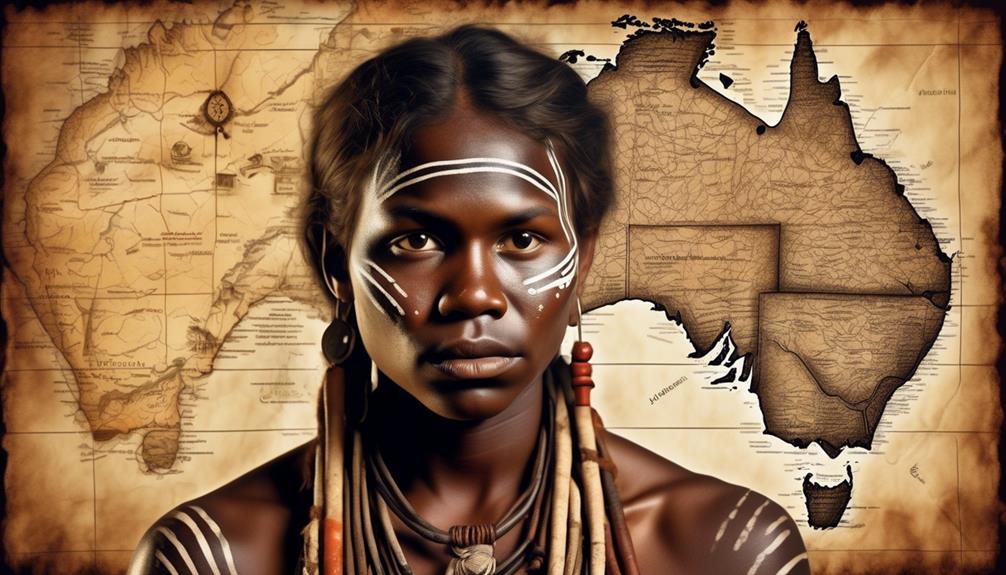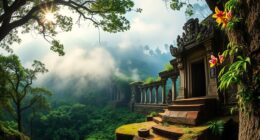When considering the Aboriginal Australians, their physical characteristics often reflect their diverse and rich cultural heritage. Over the years, various sources have provided perspectives on how they may look, from early European accounts to modern scientific studies.
But how accurate are these depictions, and what do they truly reveal about the appearance of the Aboriginal Australians? As we explore historical accounts, archaeological findings, genetic studies, oral traditions, and artistic representations, we begin to unravel the complex and fascinating story of what the original inhabitants of Australia may have looked like.
Key Takeaways
- European explorers documented physical descriptions of Aboriginal Australians, highlighting their adaptability to the environment, lean and muscular build, dark skin, and tightly curled hair.
- Aboriginal Australians have a distinct cranial morphology characterized by robust, long skulls with sloping foreheads and prominent brow ridges.
- Genetic studies show that Aboriginal Australians have the oldest continuous culture on Earth, with deep-rooted lineages and genetic connections to populations in Southeast Asia.
- Oral traditions and stories play a crucial role in preserving Aboriginal knowledge, history, and cultural values, including creation myths, ancestral beings, and the natural world.
Historical Accounts and Early Observations
Early European explorers and settlers meticulously documented their observations of the physical appearance of Aboriginal Australians, providing valuable insights into the diversity and distinctiveness of their features. These early accounts offer a fascinating glimpse into the physical descriptions of Aboriginal Australians at the time of European contact.
Descriptions consistently highlighted the remarkable adaptability of Aboriginal Australians to their environment, with references to their lean and muscular build, dark skin, and tightly curled hair. The explorers marveled at their physical prowess and noted their exceptional ability to endure the harsh Australian climate.
Additionally, there were detailed accounts of the intricate body decorations and markings that held cultural and ceremonial significance for the Aboriginal Australians. These early observations not only shed light on the physical attributes of the Aboriginal Australians but also reflect the deep admiration and respect that the observers held for their resilience and strength.
Understanding these historical accounts of physical descriptions is crucial in appreciating the rich and diverse heritage of Aboriginal Australians and can aid in fostering a deeper understanding and respect for their culture.
Archaeological Discoveries and Artifacts

Archaeological excavations and discoveries have provided invaluable insights into the material culture and lifeways of Aboriginal Australians, offering a tangible connection to the historical accounts of their physical appearance. Through archaeological evidence, we have gained a deeper understanding of the physical characteristics of Aboriginal Australians. Artifacts such as tools, rock art, and skeletal remains have shed light on their appearance, including body decoration, clothing, and adornments. Here is a comparative summary of some physical characteristics based on archaeological evidence:
| Physical Characteristic | Archaeological Evidence | Comparative Description |
|---|---|---|
| Cranial Morphology | Skulls and skeletal remains | Robust, long skulls with sloping foreheads and prominent brow ridges |
| Body Adornments | Shell beads, ochre, and pigments | Elaborate body decoration using natural materials for ceremonial and decorative purposes |
| Tool Usage | Stone tools and implements | Sophisticated tool-making skills, reflecting a deep understanding of the landscape and resources |
| Dental Wear Patterns | Teeth and jaw remains | Worn incisors and canines from using teeth as tools, indicative of their resourceful lifestyles |
These archaeological findings provide valuable insights into the physical attributes and material culture of Aboriginal Australians, enriching our understanding of their way of life.
Genetic and DNA Studies
Studying genetic and DNA data has provided significant insights into the ancestral lineages and population history of Aboriginal Australians, enhancing our understanding of their genetic diversity and evolutionary relationships.
Genetic research has revealed that Aboriginal Australians have the oldest continuous culture on Earth, with evidence suggesting they arrived in the region around 50,000 years ago.
DNA analysis has shown remarkable diversity among Aboriginal Australian populations, indicating deep-rooted genetic lineages and complex patterns of migration and intermixing.
These studies have also highlighted genetic connections between Aboriginal Australians and populations in Southeast Asia, demonstrating the intricate web of human migration and settlement across the ancient continent of Sahul.
Furthermore, genetic research has contributed to unraveling the impact of historical events, such as colonialism and the Stolen Generations, on the genetic makeup of Aboriginal Australians.
Oral Traditions and Aboriginal Stories

Investigating Aboriginal oral traditions and stories provides a unique insight into their cultural heritage, offering valuable perspectives on their beliefs, practices, and societal structures. Oral traditions are central to Aboriginal cultures, serving as a means of transmitting knowledge, history, and cultural values from one generation to another. These stories often involve creation myths, ancestral beings, and the natural world, providing a rich tapestry of cultural understanding. Through these narratives, Aboriginal communities have preserved their knowledge of the land, animals, and the cosmos, contributing to a deep sense of connection to the environment.
Aboriginal stories also play a significant role in shaping social norms and relationships within communities. They often convey moral lessons, ethical guidelines, and societal expectations, serving as a means of reinforcing cultural identity and values. Furthermore, these stories are often interconnected with specific landscapes, creating a profound link between the people and their environment.
Studying these oral traditions and Aboriginal stories not only enriches our understanding of their cultural heritage but also highlights the resilience and richness of Aboriginal societies. These narratives provide valuable insights into the complexities of their belief systems, societal structures, and the enduring significance of their cultural practices.
Reconstruction and Artistic Representations
Exploring the physical remains and artistic representations of Aboriginal Australians provides valuable insights into their appearance and the ways in which they've been depicted throughout history.
Artistic interpretations and facial reconstructions have played a crucial role in shaping our understanding of the physical characteristics of Aboriginal Australians.
Here are some key points to consider:
- Facial Reconstructions: Modern techniques of facial reconstruction, such as 3D modeling and forensic anthropology, have allowed researchers to create representations of Aboriginal individuals from different time periods. These reconstructions are based on skeletal remains and provide a glimpse into the facial features and diversity of Aboriginal populations.
- Artistic Interpretations: Throughout history, artists have depicted Aboriginal Australians in various ways, reflecting the cultural and societal perspectives of different time periods. These artistic representations, spanning from ancient rock art to contemporary paintings, offer a visual record of the diverse physical appearances and cultural practices of Aboriginal Australians.
- Evolution of Depictions: Comparing artistic representations over time reveals how the portrayal of Aboriginal Australians has evolved, influenced by societal attitudes, cultural interactions, and changing artistic styles.
Studying these reconstructions and artistic representations enhances our understanding of the physical diversity and cultural complexity of Aboriginal Australians, contributing to a more comprehensive and respectful representation of their appearance throughout history.
Frequently Asked Questions
How Did Aboriginal Australians Style Their Hair and Adorn Themselves With Jewelry and Body Art?
Hairstyle trends among Aboriginal Australians vary across different cultural groups and regions. In some communities, hair is adorned with feathers, shells, or natural materials, reflecting cultural significance.
Body art and jewelry also hold deep cultural meaning, with intricate designs and use of ochre pigments. These adornments serve as a way of expressing cultural identity and connection to the land.
The diversity in hairstyle trends and cultural adornments reflects the rich and varied cultural traditions of Aboriginal Australians.
What Were the Common Daily Activities and Rituals of Aboriginal Australians?
Daily activities among Aboriginal Australians included hunting, gathering, and tending to their land.
Traditional rituals, such as ceremonies and dances, were integral to their spiritual and cultural practices.
Adornment styles and body art were significant in expressing individual and group identities.
These activities and rituals were deeply rooted in their connection to the land and the Dreamtime, shaping their way of life and sense of belonging within their communities.
What Were the Traditional Roles and Responsibilities of Men and Women in Aboriginal Australian Societies?
In Aboriginal Australian societies, traditional roles and responsibilities were divided based on gender dynamics. Men typically engaged in activities such as hunting, trading, and making tools, while women were responsible for gathering food, raising children, and maintaining the camp.
This division of labor was grounded in cultural practices and reflected in adornment styles and communication methods. These roles were vital for the survival and thriving of the community.
What Were the Common Beliefs and Spiritual Practices of Aboriginal Australians?
Beliefs, rituals, and spiritual practices were integral to Aboriginal Australian culture. Dreamtime stories conveyed their creation beliefs, while kinship systems governed social structure.
Traditional ceremonies were central to their spiritual life, connecting them to the land and ancestors. These practices fostered a deep sense of identity and belonging.
How Did Aboriginal Australians Interact and Communicate With Each Other and With Other Neighboring Cultures?
Interpersonal communication among Aboriginal Australians was extensive, with diverse languages and dialects used for cross-cultural interactions. This facilitated trade, cultural exchange, and the sharing of knowledge.
The ability to adapt communication methods to interact with neighboring cultures allowed for mutually beneficial relationships.
The richness of this communication system reflects the depth of Aboriginal culture and the resilience of their social structures amidst diverse cultural influences.
Conclusion
In conclusion, the appearance of Aboriginal Australians was a diverse and dynamic blend of features, reflecting the rich history and heritage of their ancient culture.
Through historical accounts, archaeological discoveries, genetic studies, and oral traditions, we've gained insight into the physical characteristics of these indigenous people.
The fascinating findings reveal a fascinating fusion of facial features, skin tones, and hair textures, showcasing the remarkable and resilient nature of the Aboriginal Australian people.









